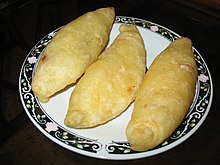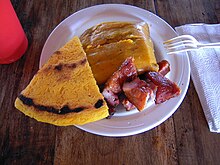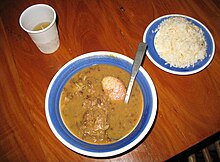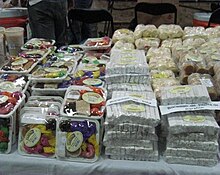| This article needs additional citations for verification. Please help improve this article by adding citations to reliable sources. Unsourced material may be challenged and removed. Find sources: "Panamanian cuisine" – news · newspapers · books · scholar · JSTOR (October 2018) (Learn how and when to remove this message) |
| Part of a series on the |
| Culture of Panama |
|---|
 |
| History |
| People |
| Languages |
| Cuisine |
| Religion |
| Art |
| Literature |
| Music |
| Media |
| Sport |
| Monuments |
| Symbols |
Panamanian cuisine is a mix of Spanish, Indigenous, and African techniques, dishes, and ingredients, reflecting its diverse population. Since Panama is a land bridge between two continents, it has a large variety of tropical fruits, vegetables and herbs that are used in native cooking.
Common ingredients in Panamanian food are maize, rice, wheat flour, plantains, yuca (cassava), beef, chicken, pork and seafood.
Dishes


Corn-based dishes come from the kernel, cooked in water and then ground in order to obtain a dough (as opposed to using corn flour to obtain the dough). Fresh corn is also used in some dishes. Due to the multicultural background of the Panamanians, many of its dishes are heavily influenced by the cuisine of other Latin American countries and also the Caribbean as well as European. Some of the main meals, dishes and specialties include:
- Almojábanos – S-shaped corn fritters.
- Arroz con camarones y coco – rice with shrimp and coconut milk.
- Arroz con chorizo y ajíes dulces
- Arroz con pollo
- Arroz con puerco y vegetales
- Arroz verde
- Bistec de higado – liver steak
- Bistec picado – chopped beefsteak.
- Bollos – corn dough wrapped in nahuala palm leaves, corn husk or plantain leaves and boiled. There are two main varieties: fresh corn bollos (bollos de maíz nuevo) and dry corn bollos. The dry corn type is sometimes flavored with butter, corn, or stuffed with beef, which is called bollo "preñado" (lit. "pregnant bollo"). Bollos have been described as a type of tamale.
- Carne entomatada
- Carimañola – similar to an empanada, but made from yuca and stuffed with beef
- Ceviche – commonly made from corvina and tilapia
- Chorizo con vegetales
- Chuletas en salsa de piña
- Empanadas – made either from flour or corn, and stuffed with meats and/or vegetables, cheese, and sometimes sweet fillings, such as fruit marmalade or manjar blanco (dulce de leche).
- Ensalada de papas – potato salad, called ensalada de feria when beetroot is added.
- Fried fish
- Gaucho soup
- Hojaldres/Hojaldras – a type of fry-bread, similar to South American countries, known in other countries as "blach tostones".
- Lengua guisada – stewed beef tongue
- Mondongo a la culona – stewed beef tripe
- Palm tree flower – prepared like spaghetti
- Pernil de puerco al horno – roasted pork leg
- Plátano en tentacion – ripe plantain cooked in a sweet syrup.
- Ropa vieja
- Salpicón de carne

- Sancocho
- Tamal de olla
- Tamales
- Tortillas – these can be around ten to twelve inches in diameter (these are always cooked on a griddle), or smaller, around four inches (most of the time these are fried).
- Torrejitas (Pastelitos) de maíz – A fresh corn fritter.
- Tortilla Changa – a thick tortilla made out of fresh corn.
- Tasajo – dried, sometimes smoked meat, usually from beef though the word refers mainly to the mode of curing rather than the type of meat.
Desserts

- Bocadillo – Hardened square milk candies.
- Bocado de la reina
- Bolitas de tamarindo – Sugar balls with tamarind fruit.
- Cabanga
- Cocadas
- Cocadas – Coconut rolled candy made from condensed milk.
- Dulce de papaya
- Flan – Rimmed pastry or sponge base containing a sweet or savoury filling.
- Gollería – sweetened plantain fritter
- Huevitos de leche- Balls of milk candy
- Mamallena
- Manjar or manjar blanco
- Mazamorra or pesada de nance
- Meringue – Whipped eggs and sugar baked.
- Orejitas – Ear shaped sugar coated flour.
- Queque
- Seasonal pineapple – grown in Panama using a hybrid of Hawaiian pineapple, it is very sweet
- Sopa borracha
- Suspiros – Wafers made from flour that release air when you bite.
- Tres leches
Drinks

In Panama there were bars that catered to local businessmen, tourists and gamblers and some that were frequented by US military personnel. The latter mostly had a reputation as "shot and beer" dives with unknown names. One of these bars, Kresch's Place, published a drink recipe book. Several of the drinks are named after bases, submarines, forts, ships and other military institutions. The "U.S.S. 44 Special" was Old Tom gin, sloe gin and lime juice. The U.S.S. Mallard was aged rum (Panamanian, Venezuelan and Colombian), red vermouth, Bénédictine, absinthe, Angostura bitters garnished with lemon peel. The cover of the recipe book shows soldiers, sailors and an Army officer drinking.
- Beer
- Chicha
- Chicheme
- Coffee
- Fresh fruit juices (licuados or jugos naturales) – pineapple, passionfruit, papaya, orange, tree tomato, etc. are prepared by blending fresh fruit and straining; typically heavily sweetened and optionally with condensed milk added
- Malteada – a malted eskimo-like milkshake without ice cream
- Resbaladera
- Ron ponche
- Saril – a drink containing sorrel sepals, ginger, cinnamon, cloves, sugar, water, and a splash of rum)
- Seco Herrerano
Spices
- Achiote – common in Panamanian cuisine
- Aji chombo – a hot pepper grown in local regions
Special occasions
Christmas
The traditional Panamanian dish for Christmas usually includes chicken tamales, arroz con pollo (rice with chicken), puerco asado, pernil, pavo (turkey), and relleno (stuffing). Bowls of fruits and fruitcake are set out on the tables along with the dishes. Along with these foods and dessert, a traditional drink is served called ron ponche (eggnog).
See also
References
- ^ Baker, C.P.; Mingasson, G. (2007). Panama. National Geographic traveler. National Geographic Society. pp. 22–23. ISBN 978-1-4262-0146-2. Retrieved October 17, 2018.
- "Eating Down South: The Panama Experience". Jamaica Observer. November 28, 2016. Retrieved October 18, 2018.
- "This Cheese Curl Gets Its Own Festival". Atlas Obscura. Retrieved 17 October 2018.
- ^ Helstosky, C. (2014). The Routledge History of Food. Routledge Histories. Taylor & Francis. p. 296. ISBN 978-1-317-62113-3. Retrieved October 17, 2018.
- "The Exotic and Tempting Ethnic Food of Panama". Tastessence. Retrieved 17 October 2018.
- ^ Orr, S. (2014). The New American Herbal. Crown Publishing Group. p. 159. ISBN 978-0-449-81993-7. Retrieved October 17, 2018.
- Helstosky, C. (2014). The Routledge History of Food. Routledge Histories. Taylor & Francis. p. pt554. ISBN 978-1-317-62112-6. Retrieved October 17, 2018.
- Kraig, B.; D, C.T.S.P. (2013). Street Food around the World: An Encyclopedia of Food and Culture: An Encyclopedia of Food and Culture. ABC-CLIO. p. 82. ISBN 978-1-59884-955-4. Retrieved October 17, 2018.
- Howard, A. (1999). Central America. Fodor's Up Close Series. Fodor's Travel Publications. p. 307. ISBN 978-0-679-00311-3. Retrieved October 17, 2018.
- Goody, C.M.; Drago, L.; American Dietetic Association (2010). Cultural Food Practices. American Dietetic Association. p. 57. ISBN 978-0-88091-433-8. Retrieved October 17, 2018.
- Berrío-Lemm, V. (2003). Panamá: tierra, gente, legado -- centenario: aproximación a las raíces del hombre panameño. Panamá (in Spanish). Ediciones del Istmo. pp. 701, 706. Retrieved October 21, 2018.
- Berrío-Lemm, V. (2003). Panamá: tierra, gente, legado - centenario: aproximación a las raíces del hombre panameño (in Spanish). Ediciones del Istmo. p. 344. Retrieved October 21, 2018.
- ^ Bolongaro, Kait (December 27, 2016). "Don't Know Panamanian Food? These Chefs Aim To Change That". NPR. Retrieved October 18, 2018.
- Fodor's Travel Publications, I.S.; Kast, M.E.; Mattson, S.; Van Fleet, J. (2010). Fodor's Panama, 2nd Edition. Fodor's Panama. Fodors Travel Pub. p. 20. ISBN 978-1-4000-0429-4. Retrieved October 17, 2018.
- Caras y caretas (in Spanish). 1929. Retrieved October 21, 2018.
- Cameron, S.; Box, B. (1999). Mexico & Central America Handbook. Footprint Central America Handbook (in Italian). Footprint Handbooks. p. 1168. ISBN 978-0-8442-4838-7. Retrieved October 17, 2018.
- ^ "Panama Desserts". amble.com. Archived from the original on 10 April 2019. Retrieved 22 October 2018.
- Soley, L.V.M.S. (2008). Culture and Customs of Panama. Cultures and Customs of the World. ABC-CLIO. p. 33. ISBN 978-0-313-05636-9. Retrieved October 17, 2018.
- "See this, skip that: Panama City, Panama". ABC News. April 17, 2018. Retrieved October 18, 2018.
- Nevins, D.; Quek, L.; Hassig, S.M. (2016). Panama: Third Edition. Cultures of the World (Third Edition). Cavendish Square Publishing. p. 128. ISBN 978-1-5026-2215-0. Retrieved October 17, 2018.
- Sweet Treats around the World: An Encyclopedia of Food and Culture: An Encyclopedia of Food and Culture. ABC-CLIO. 2014. p. 68. ISBN 978-1-61069-221-2. Retrieved October 17, 2018.
- "Lost Cocktail Culture: Navy Drinks from the Panama Canal Zone". The Daily Beast. September 5, 2019. Retrieved 6 September 2019.
- Soley, L.V.M.S. (2008). Culture and Customs of Panama. Cultures and Customs of the World. ABC-CLIO. p. 31. ISBN 978-0-313-05636-9. Retrieved October 17, 2018.
- ^ García, Deysi. "Ron ponche, la bebida en Navidad". Telemetro (in Spanish). Retrieved October 19, 2018.
- Foster, D. (2002). Global Etiquette Guide to Mexico and Latin America. John Wiley & Sons. p. 87. ISBN 978-0-471-27283-0. Retrieved October 17, 2018.
- ^ Kopka, D. (2011). Welcome to Panama: Passport to Central & South America. Passport Series. p. 121. ISBN 978-0-7877-2768-0. Retrieved October 19, 2018.
Further reading
- Gill, Nicholas (March 23, 2014). "In Panama City, Mixing Global and Local Flavors". The New York Times. Retrieved October 18, 2018.
External links
- [REDACTED] Media related to Cuisine of Panama at Wikimedia Commons
| Panama articles | |||||
|---|---|---|---|---|---|
| History | |||||
| Geography | |||||
| Politics | |||||
| Economy | |||||
| Society |
| ||||
| North American cuisine | |
|---|---|
| Sovereign states | |
| Dependencies and other territories | |